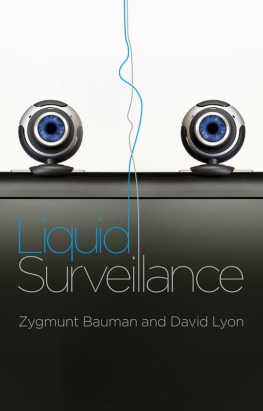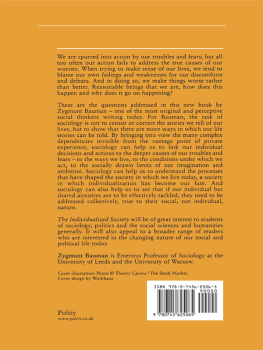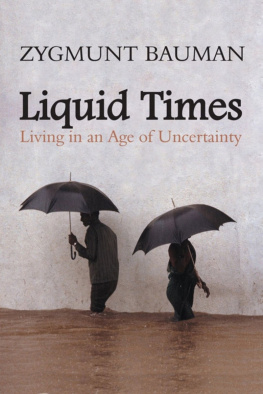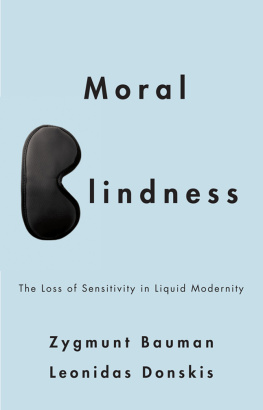Liqui d Survei llance
Liquid Surv eillance
A Conversation
Zygmunt Bauman and David Lyon
polity
Copyright Zygmunt Bauman and David Lyon 2013
The right of Zygmunt Bauman and David Lyon to be identified as Authors of this Work has been asserted in accordance with the UK Copyright, Designs and Patents Act 1988.
First published in 2013 by Polity Press
Polity Press
65 Bridge Street
Cambridge CB2 1UR, UK
Polity Press
350 Main Street
Malden, MA 02148, USA
All rights reserved. Except for the quotation of short passages for the purpose of criticism and review, no part of this publication may be reproduced, stored in a retrieval system, or transmitted, in any form or by any means, electronic, mechanical, photocopying, recording or otherwise, without the prior permission of the publisher.
ISBN: 978-0-7456-6402-6
A catalogue record for this book is available from the British Library.
The publisher has used its best endeavours to ensure that the URLs for external websites referred to in this book are correct and active at the time of going to press. However, the publisher has no responsibility for the websites and can make no guarantee that a site will remain live or that the content is or will remain appropriate.
Every effort has been made to trace all copyright holders, but if any have been inadvertently overlooked the publisher will be pleased to include any necessary credits in any subsequent reprint or edition.
For further information on Polity, visit our website: www.politybooks.com
Preface and acknowledgements
Surveillance is a growing feature of daily news, reflecting its rapid rise to prominence in many life spheres. But in fact surveillance has been expanding quietly for many decades and is a basic feature of the modern world. As that world has transformed itself through successive generations, so surveillance takes on an ever changing character. Today, modern societies seem so fluid that it makes sense to think of them being in a liquid phase. Always on the move, but often lacking certainty and lasting bonds, todays citizens, workers, consumers and travellers also find that their movements are monitored, tracked and traced. Surveillance slips into a liquid state.
This book examines through conversation how far the notion of liquid surveillance helps us grasp what is happening in the world of monitoring, tracking, tracing, sorting, checking and systematic watching that we call surveillance. This provides the key thread through our conversation. It engages with both historical debates over the panopticon design for surveillance as well as contemporary developments in a globalized gaze that seems to leave nowhere to hide, and simultaneously is welcomed as such. But it also stretches outwards to touch large questions sometimes unreached by debates over surveillance. It is a conversation in which each participant contributes more or less equally to the whole.
The two of us have been in touch, discussing sporadically issues of new technologies, surveillance, sociology and social theory since the late 1970s (or early 1980s, we cant recall). Bauman has continued to use the panop ticon critique and related themes in his work and has encouraged Lyon in his growing analysis of surveillance. Most recently, we prepared back-to-back presentations for the Surveillance Studies Network biannual conference in 2008 (Baumans had to be given in absentia). Lyons was published in International Political Sociology (Dec. 2010) as Liquid surveillance: the contribution of Zygmunt Baumans work to surveillance studies. Baumans contribution to that event is unpublished. Our conversation occurred by email between September and November 2011.
Were very grateful for the very thoughtful help given by some valued colleagues in reading our conversation and making suggestions for how things might be better put, and made more accessible to a wider audience: Katja Franko Aas, Kirstie Ball, Will Katerberg, Keith Tester. Warm thanks are also due to Emily Smith, Research Associate at the Surveillance Studies Centre at Queens University, Canada for help with this project, and Andrea Drugan, our Polity editor, and Ann Bone, copy-editor, for their encouragement and advice.
Zygmunt Bauman and David Lyon
Introduction
David Lyon Surveillance is a key dimension of the modern world and in most countries people are all too aware of how surveillance affects them. Not only in London and New York but also in New Delhi, Shanghai and Rio de Janeiro video cameras are a familiar sight in public places. Travellers through airports everywhere are conscious that they not only have to negotiate twentieth-century passport control but also newer devices such as body scanners and biometric checks that have proliferated since 9/11. And if these have to do with security, other kinds of surveillance, relating to routine and mundane purchases or online access or participation in social media, are also increasingly ubiquitous. We have to show ID, insert passwords and use coded controls in numerous contexts from making online purchases to entering buildings. Every day, Google notes our searches, prompting customized marketing strategies.
But what does this mean, socially, culturally, politically? If we simply start with new technologies or regulatory regimes we may acquire some sense of the scope of this phenomenon but will we understand it? Certainly, getting an idea of the magnitude and rapid spread of data processing is vital if the surveillance surge is to be appreciated for what it is, and discovering just whose life chances and opportunities are affected by surveillance will galvanize efforts to rein it in. But this conversation is intended to do more, to dig deeper to probe the historical and Western origins of todays surveillance and to raise ethical as well as political queries about its expansion.
Surveillance has been a constant theme of Zygmunt Baumans work over several decades and many of his observations are, in my view, of great interest to those trying to understand and respond to surveillance today. In the first decade of the twenty-first century Bauman became best known for his reflections on the rise of liquid modernity and here we explore how far this frame is also illuminating for considering the contemporary role of surveillance. But the other leitmotif of Baumans analysis is the stress on ethics, above all the ethics of the Other. To what extent does this offer a critical handle on surveillance today?
Liquid surveillance?
Liquid surveillance is less a complete way of specifying surveillance and more an orientation, a way of situating surveillance developments in the fluid and unsettling modernity of today. Surveillance softens especially in the consumer realm. Old moorings are loosened as bits of personal data extracted for one purpose are more easily deployed in another. Surveillance spreads in hitherto unimaginable ways, responding to and reproducing liquidity. Without a fixed container, but jolted by security demands and tipped by technology companies insistent marketing, surveillance spills out all over. Baumans notion of liquid modernity frames surveillance in new ways and offers both striking insights into why surveillance develops the way it does and some productive ideas on how its worst effects might be confronted and countered. Of course, thats my view of the situation. What Zygmunt Bauman thinks becomes clear in our conversation
















